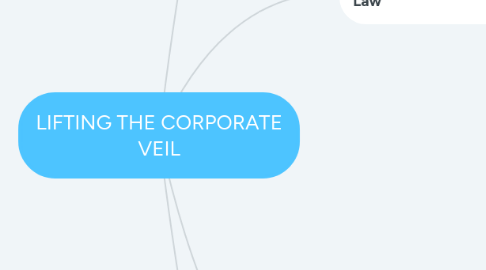
1. Effects
1.1. To identify the company with other persons that is its members or directors
1.2. To treat a group of companies as a single commercial entity
1.3. Theta Edge Bhd v Infornential Sdn Bhd and another appeal [2017] mlju 157 and Ong Thean Chye & Ors v Tiew Choy Chai & Anor [2011] 4 mlj 616
2. Judicial Exceptions / Common Law
2.1. The court will use its power to determine whether the company can be treated separately from its members, or they are considered as the same entity.
2.2. will be used by the court if it involvers the interest of the shareholders, creditors or stakeholders.
2.3. disregard the rule of separate legal entity of the company.
2.4. 1. Using a company to evade legal obligations or to commit fraud
2.4.1. Gilford Motor Co v Horne: the court granted an injunction against Horne and his company for breaching the agreement
2.4.2. Chew Siang Jin v Lau Chee Ching & Ors: the court agreed to lift the corporate veil and treated the company and its shareholders as one and the same entity.
2.5. 2. A company has been controlled and become and an agent to its controller
2.5.1. Aspatra Sdn Bhd v Bank Bumiputra Malaysia Bhd: The court found that Lorrain had used his shareholdings and directorships to control the company.
2.6. 3. Group of companies
2.6.1. In certain situations, a company and its subsidiary may be treated as a single corporate entity.
2.6.2. Hotel Jaya Puri Bhd v National Union of Hotel, Bar and Restaurant Workers: The court ignored the separate entities of the Restaurant and the Hotel and treat them as one single entity.
2.7. 4. Where the court exercises an equitable discretion
2.7.1. Aspatra Sdn Bhd & Ors v BBMB Bhd & Anor: The court will use its own discretion to ignore the doctrine of separate legal entity of the company, if it thinks just and equitable to do so.
3. Statutory Exceptions Under companies act 1965
3.1. 1. Liability of directors for repayment of money in relation to share issuance, under sec 186(4)(b)
3.1.1. Public company may raise money by issuance of share to the public
3.1.2. Shares shall not be allotted unless the minimum subscription is met and the sum received by the company
3.2. 2. Wrongful and fraudulent trading under section 539(3)
3.2.1. It is an offence for an officer who knowingly contracts a debt with no reasonable or probable ground of expectation that the company would be able to pay the debt
3.3. 3. Liability of an officer for debts incurred by the company under section 540
3.3.1. If the company is being wound up but it continues to trade and incur debts with intent to defraud creditors or for any fraudulent purpose.
3.3.2. The liquidator can apply to court to declare that the party is personally liable for all or any debts incurred.
4. Statutory Exceptions Under other statutes
4.1. Income Tax Act 1967: Section 140(1)
4.2. Employee Provident Funds Act1991: Section 46(1)
4.3. Crimes by the company
4.3.1. A company can be held liable for crime if the directors or other officers fulfilled the requirement of actus reus and mens
4.3.2. Yap Sing Hock & Anor v Public Prosecutor
